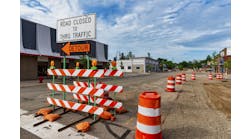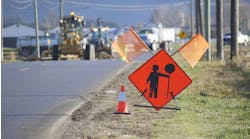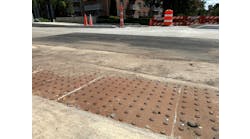The Connecticut Department of Transportation’s (CTDOT) CTfastrak is a dedicated bus rapid transit (BRT) system that will help riders circumvent growing highway traffic congestion between New Britain and Hartford, Conn., with fast, flexible direct buses.
Operating much like a rail transit line, the 9.4-mile BRT line will run on a dedicated roadway constructed along abandoned and active right-of-way railroad corridors, with limited stops at 10 stations located approximately 1 mile apart along the route.
Currently, Connecticut’s BRT line, a promising public transportation solution to overcrowded transportation arteries, is under construction with considerable support from local government leaders and the interested communities—though that was not always the case.
Not long ago, CTDOT faced a number of social, political and economic concerns from the four very different communities involved in the CTfastrak line. Each had considerably different perspectives and desires about the overall concept of the BRT line and of the proposed stations, specifically, that had to be resolved before the project could move forward.
With a focus on context-sensitive design, the design team engaged with the communities to develop bus-station concepts that met the system objectives and the functional desires of each community with efficiency and affordability.
Stations in accord
The CTfastrak corridor passes through four different communities—the capital city of Hartford, the inner-ring suburb of West Hartford, the primarily residential town of Newington and the manufacturing, high-tech college town of New Britain.
A total of 10 different station platforms are needed along the route: three in New Britain (New Britain Downtown, East Main Street and East Street Station); two in Newington (Cedar and Newington Junction); two in West Hartford (Elmwood and Flatbush Avenue); and three in Hartford (Kane Street, Parkville and Sigourney Street).
At every location, the goal is to design and construct a station that more resembles a train station than a conventional bus stop. For consistency, the basic architecture of every station is the same, with two basic structures: There is a shell with a curved shape and arches that use the same curve/geometric line but on end, much like a double-stemmed mushroom. The modular design incorporates some basic precast and structural steel elements that can be fabricated offsite and then brought to the station site for quick erection.
Every CTfastrak station also will include basic elements: a raised station platform to allow fast, level boarding; multiple shelters with seating; bicycle racks; ticket vending machines; maps of routes and the surrounding neighborhood; and landscaping. Electronic displays at each station will let passengers know when their bus will be arriving, and closed-circuit cameras at the stations will enhance passenger security. Smart technology will allow every station and bus to talk to each other. Buses will make automatic onboard station announcements, and stations will give passengers real-time information when vehicles will arrive.
Community melody
In an effort to encourage public input and develop community-tailored station designs, Kleinfelder launched a comprehensive public outreach program using context-sensitive solutions and low-impact-design transportation planning processes.
In the early conceptual-design days, the Kleinfelder team provided the communities with multiple design charrettes as a way to open dialogue and solicit input. The goal was not to inform or dictate a concept but to engage the community through face-to-face meetings. At these meetings, the interested parties had an opportunity to discuss operational needs, priorities and architectural treatments.
As part of the public forum and context-sensitive-solution philosophy, the Kleinfelder team intentionally did not present a design or even a proposed rendering, preferring instead to provide general guidelines of the station characteristics, such as size, and then solicit ideas from the public about what they would like to see.
Kleinfelder has found that in somewhat controversial projects—or at least projects that are not wholeheartedly desired by the entire community—it is best to go into the open houses and planning meetings with less-is-more design charrettes.
The interactive public workshops went well beyond the common open floor presentation and question-answer format.
At every station workshop, the design team introduced the project and then broke out into different working groups with three or four facilitators to delve deeper into specific elements of the station designs.
Notes at work
Breakout-group site discussions, which lasted about an hour, included: pedestrian traffic flow/connections, vehicular routing, parking, open space, platforms/buildings, aesthetics/visual character/materials, safety/security, accessibility, station amenities, neighborhood or community concerns and even station naming conventions. In all cases, the interactive workshops provided much-needed insight about the community and its needs.
For example, in New Britain, community participants voiced the desire to have all three New Britain stations have the same canopy, so riders would know they were in their town. Other participants were concerned that there would not be adequate sidewalks to, from and within the station.
In Newington, working-group participants for the Cedar Street Station emphasized the importance of additional bike access and pedestrian-friendly access to support the high number of college students traveling to attend Central Connecticut State University. Another working group focused on architectural details. Newington has retained its historic colonial architecture and wanted the station to reflect that look and feel. Specifically, the community wanted the historic railroad depot building at the Newington Junction Station to be incorporated into the designs if possible. Kleinfelder was able to accommodate the request.
Working groups also helped design West Hartford’s Flatbush Avenue Station to improve safe, secure access. The design will include a large center island platform where all CTfastrak buses will stop, an express lane on the dedicated roadway for buses that bypass the station, a local bus stop on New Park Avenue and a limited number of parking spaces and a convenient drop-off location inside the parking area for riders.
In every case, once the working groups finalized ideas, the design team would bring the entire group back together to talk through the ideas developed in the working groups. The working groups helped the design team focus the station concepts in a direction that would be most amenable to the individual community.
In some cases, community involvement far exceeded expectations, and the design team added more workshops to continue relevant discussions. For example, the Parkville Station in Hartford was very involved in every public forum discussion about the station and took the time to talk about how they’d like to see the bus station fit into their community. One of the ideas that came out of a working group related to the community’s annual parade. Residents thought it would be great to have a terraced viewing area built into the station so residents could watch in comfortable seats above the parade—and Kleinfelder was able to accommodate them.
The Parkville Station concept is an example of the context-sensitive-design methodology at its best.
Downbeat in 2015
Construction of the BRT line and stations began in May 2012. The guideway is complete, as are the necessary bridges. To date, all 10 stations are under construction, with substantial construction of the entire project on schedule for fall 2014, at which time, CTDOT will begin testing the guideway and training drivers.
Anticipated to open in 2015, the BRT line will offer motorists a public transportation alternative, reduce roadway congestion and improve the region’s air quality by reducing the amount of single-occupant vehicles. CTfastrak is expected to carry approximately 16,000 riders a day, thus removing about 17 million vehicle-miles per year from the roadway.
CTDOT and the Federal Transit Administration expect the CTfastrak project to become a model for another 16 BRT lines planned in communities across the country. TM&E


